roof rack FORD ESCAPE 2015 3.G Owners Manual
[x] Cancel search | Manufacturer: FORD, Model Year: 2015, Model line: ESCAPE, Model: FORD ESCAPE 2015 3.GPages: 449, PDF Size: 5.36 MB
Page 6 of 449

Refueling..........................................................134
Fuel Consumption........................................135
Emission Control System..........................136
Transmission
Automatic Transmission............................139
Four-Wheel Drive
Principle of Operation.................................142
Using Four-Wheel Drive.............................142
Brakes
General Information
....................................147
Hints on Driving With Anti-Lock Brakes...........................................................147
Parking Brake
.................................................148
Hill Start Assist..............................................148
Traction Control
Principle of Operation................................149
Using Traction Control...............................149
Stability Control
Principle of Operation................................150
Using Stability Control.................................151
Parking Aids
Parking Aid......................................................152
Active Park Assist
.........................................154
Rear View Camera
.......................................158
Cruise Control
Principle of Operation..................................161
Using Cruise Control.....................................161
Driving Aids
Blind Spot Information System..............162
Eco Mode
........................................................166
Steering............................................................166 Load Carrying
Rear Under Floor Storage.........................168
Luggage Covers
.............................................168
Roof Racks and Load Carriers.................169
Load Limit........................................................170
Towing
Towing a Trailer..............................................178
Trailer Sway Control.....................................179
Recommended Towing Weights
.............179
Essential Towing Checks
............................181
Towing Points
................................................183
Transporting the Vehicle...........................184
Towing the Vehicle on Four Wheels......185
Driving Hints
Breaking-In.....................................................186
Economical Driving
......................................186
Driving Through Water................................187
Floor Mats........................................................187
Roadside Emergencies
Roadside Assistance..................................189
Hazard Warning Flashers
..........................190
Fuel Shutoff
...................................................190
Jump Starting the Vehicle..........................191
Post-Crash Alert System...........................193
Customer Assistance
Getting the Services You Need...............194
In California (U.S. Only).............................195
The Better Business Bureau (BBB) Auto Line Program (U.S. Only)......................196
Utilizing the Mediation/Arbitration Program (Canada Only)
........................196
Getting Assistance Outside the U.S. and Canada.........................................................197
Ordering Additional Owner's Literature.....................................................198
3
Escape (TM2), enUSA, First Printing Table of Contents
Page 153 of 449

PRINCIPLE OF OPERATION
WARNINGS
Vehicle modifications involving
braking system, aftermarket roof
racks, suspension, steering system,
tire construction and wheel and tire size
may change the handling characteristics
of your vehicle and may adversely affect
the performance of the AdvanceTrac
system. In addition, installing any stereo
loudspeakers may interfere with and
adversely affect the AdvanceTrac system.
Install any aftermarket stereo loudspeaker
as far as possible from the front center
console, the tunnel, and the front seats in
order to minimize the risk of interfering with
the AdvanceTrac sensors. Reducing the
effectiveness of the AdvanceTrac system
could lead to an increased risk of loss of
vehicle control, vehicle rollover, personal
injury and death. Remember that even advanced
technology cannot defy the laws of
physics. It’
s always possible to lose
control of a vehicle due to inappropriate
driver input for the conditions. Aggressive
driving on any road condition can cause
you to lose control of your vehicle
increasing the risk of personal injury or
property damage. Activation of the
AdvanceTrac system is an indication that
at least some of the tires have exceeded
their ability to grip the road; this could
reduce the operator ’s ability to control the
vehicle potentially resulting in a loss of
vehicle control, vehicle rollover, personal
injury and death. If your AdvanceTrac
system activates, SLOW DOWN. The AdvanceTrac with Roll Stability
Control system helps you keep control of
your vehicle when on a slippery surface.
The electronic stability control portion of
the system helps avoid skids and lateral
slides and roll stability control helps avoid
a vehicle rollover. The traction control
system helps avoid drive wheel spin and
loss of traction. See Using Traction
Control (page 149). Vehicle without AdvanceTrac
with RSC skidding off its
intended route.
A
Vehicle with AdvanceTrac with
RSC maintaining control on a
slippery surface.
B
150
Escape (TM2), enUSA, First Printing Stability ControlE72903A
AA
B
BB
B
Page 157 of 449
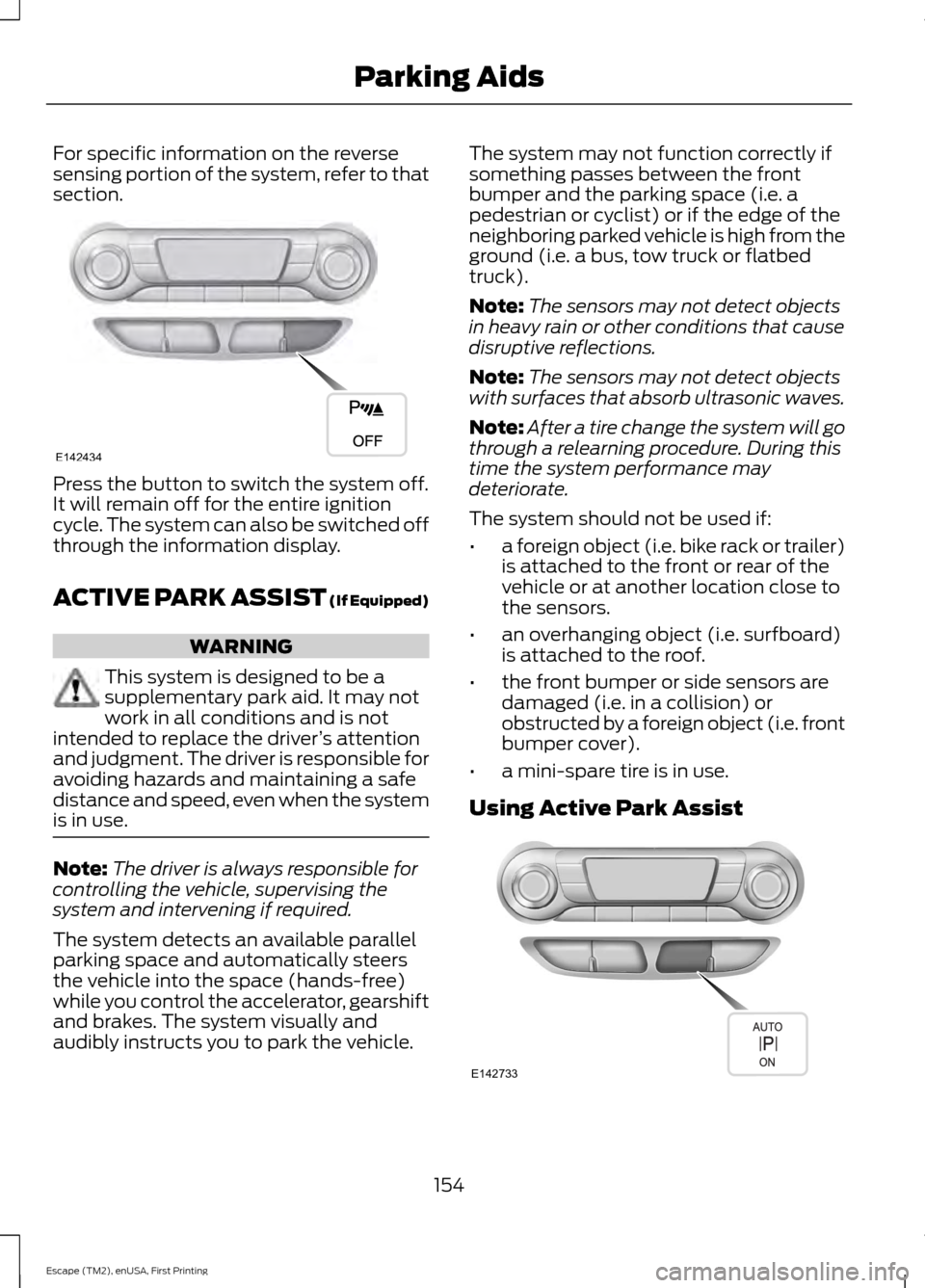
For specific information on the reverse
sensing portion of the system, refer to that
section.
Press the button to switch the system off.
It will remain off for the entire ignition
cycle. The system can also be switched off
through the information display.
ACTIVE PARK ASSIST (If Equipped)
WARNING
This system is designed to be a
supplementary park aid. It may not
work in all conditions and is not
intended to replace the driver ’s attention
and judgment. The driver is responsible for
avoiding hazards and maintaining a safe
distance and speed, even when the system
is in use. Note:
The driver is always responsible for
controlling the vehicle, supervising the
system and intervening if required.
The system detects an available parallel
parking space and automatically steers
the vehicle into the space (hands-free)
while you control the accelerator, gearshift
and brakes. The system visually and
audibly instructs you to park the vehicle. The system may not function correctly if
something passes between the front
bumper and the parking space (i.e. a
pedestrian or cyclist) or if the edge of the
neighboring parked vehicle is high from the
ground (i.e. a bus, tow truck or flatbed
truck).
Note:
The sensors may not detect objects
in heavy rain or other conditions that cause
disruptive reflections.
Note: The sensors may not detect objects
with surfaces that absorb ultrasonic waves.
Note: After a tire change the system will go
through a relearning procedure. During this
time the system performance may
deteriorate.
The system should not be used if:
• a foreign object (i.e. bike rack or trailer)
is attached to the front or rear of the
vehicle or at another location close to
the sensors.
• an overhanging object (i.e. surfboard)
is attached to the roof.
• the front bumper or side sensors are
damaged (i.e. in a collision) or
obstructed by a foreign object (i.e. front
bumper cover).
• a mini-spare tire is in use.
Using Active Park Assist 154
Escape (TM2), enUSA, First Printing Parking AidsE142434 E142733
Page 172 of 449
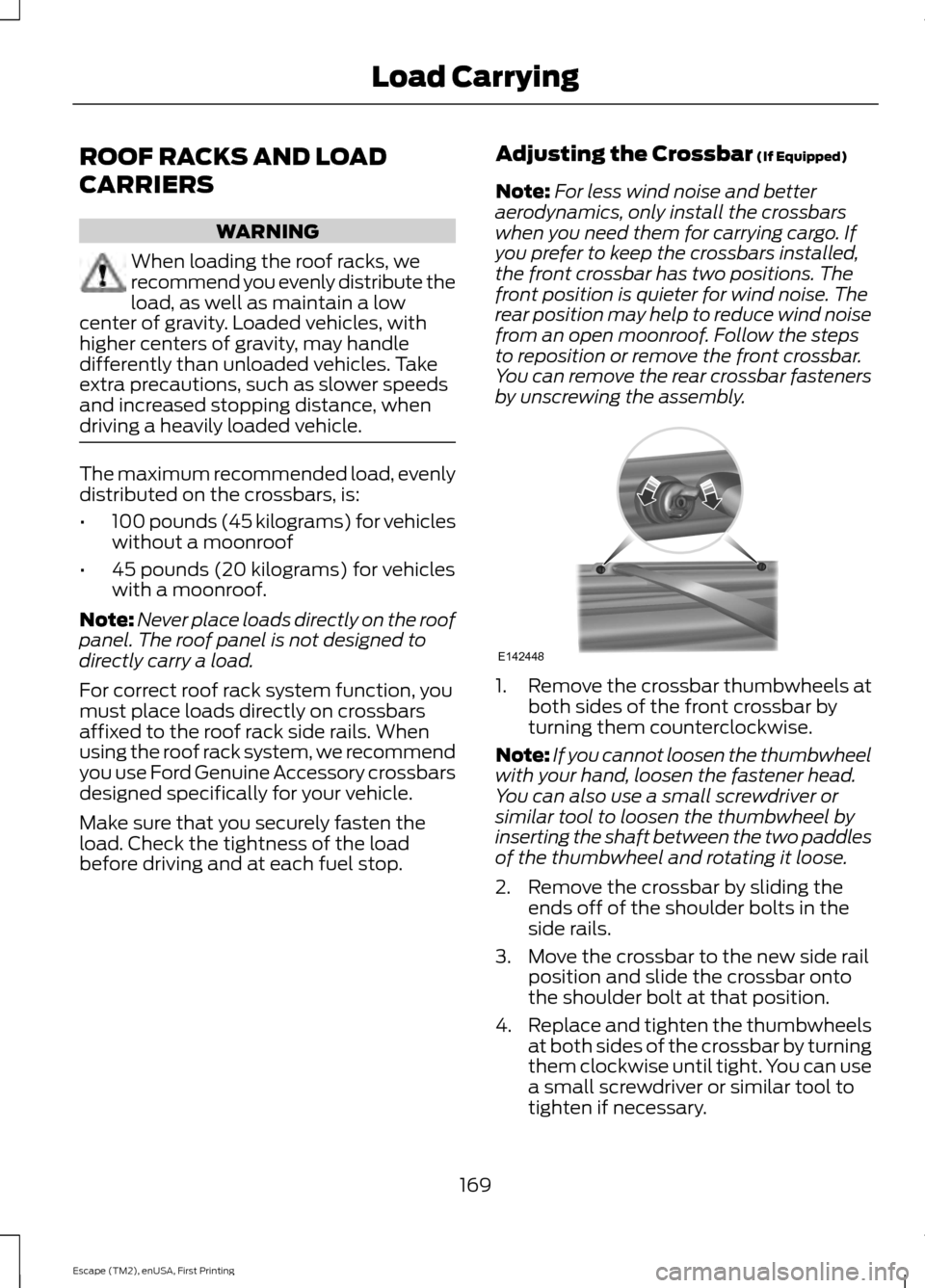
ROOF RACKS AND LOAD
CARRIERS
WARNING
When loading the roof racks, we
recommend you evenly distribute the
load, as well as maintain a low
center of gravity. Loaded vehicles, with
higher centers of gravity, may handle
differently than unloaded vehicles. Take
extra precautions, such as slower speeds
and increased stopping distance, when
driving a heavily loaded vehicle. The maximum recommended load, evenly
distributed on the crossbars, is:
•
100 pounds (45 kilograms) for vehicles
without a moonroof
• 45 pounds (20 kilograms) for vehicles
with a moonroof.
Note: Never place loads directly on the roof
panel. The roof panel is not designed to
directly carry a load.
For correct roof rack system function, you
must place loads directly on crossbars
affixed to the roof rack side rails. When
using the roof rack system, we recommend
you use Ford Genuine Accessory crossbars
designed specifically for your vehicle.
Make sure that you securely fasten the
load. Check the tightness of the load
before driving and at each fuel stop. Adjusting the Crossbar (If Equipped)
Note: For less wind noise and better
aerodynamics, only install the crossbars
when you need them for carrying cargo. If
you prefer to keep the crossbars installed,
the front crossbar has two positions. The
front position is quieter for wind noise. The
rear position may help to reduce wind noise
from an open moonroof. Follow the steps
to reposition or remove the front crossbar.
You can remove the rear crossbar fasteners
by unscrewing the assembly. 1.
Remove the crossbar thumbwheels at
both sides of the front crossbar by
turning them counterclockwise.
Note: If you cannot loosen the thumbwheel
with your hand, loosen the fastener head.
You can also use a small screwdriver or
similar tool to loosen the thumbwheel by
inserting the shaft between the two paddles
of the thumbwheel and rotating it loose.
2. Remove the crossbar by sliding the ends off of the shoulder bolts in the
side rails.
3. Move the crossbar to the new side rail position and slide the crossbar onto
the shoulder bolt at that position.
4. Replace and tighten the thumbwheels
at both sides of the crossbar by turning
them clockwise until tight. You can use
a small screwdriver or similar tool to
tighten if necessary.
169
Escape (TM2), enUSA, First Printing Load CarryingE142448
Page 173 of 449
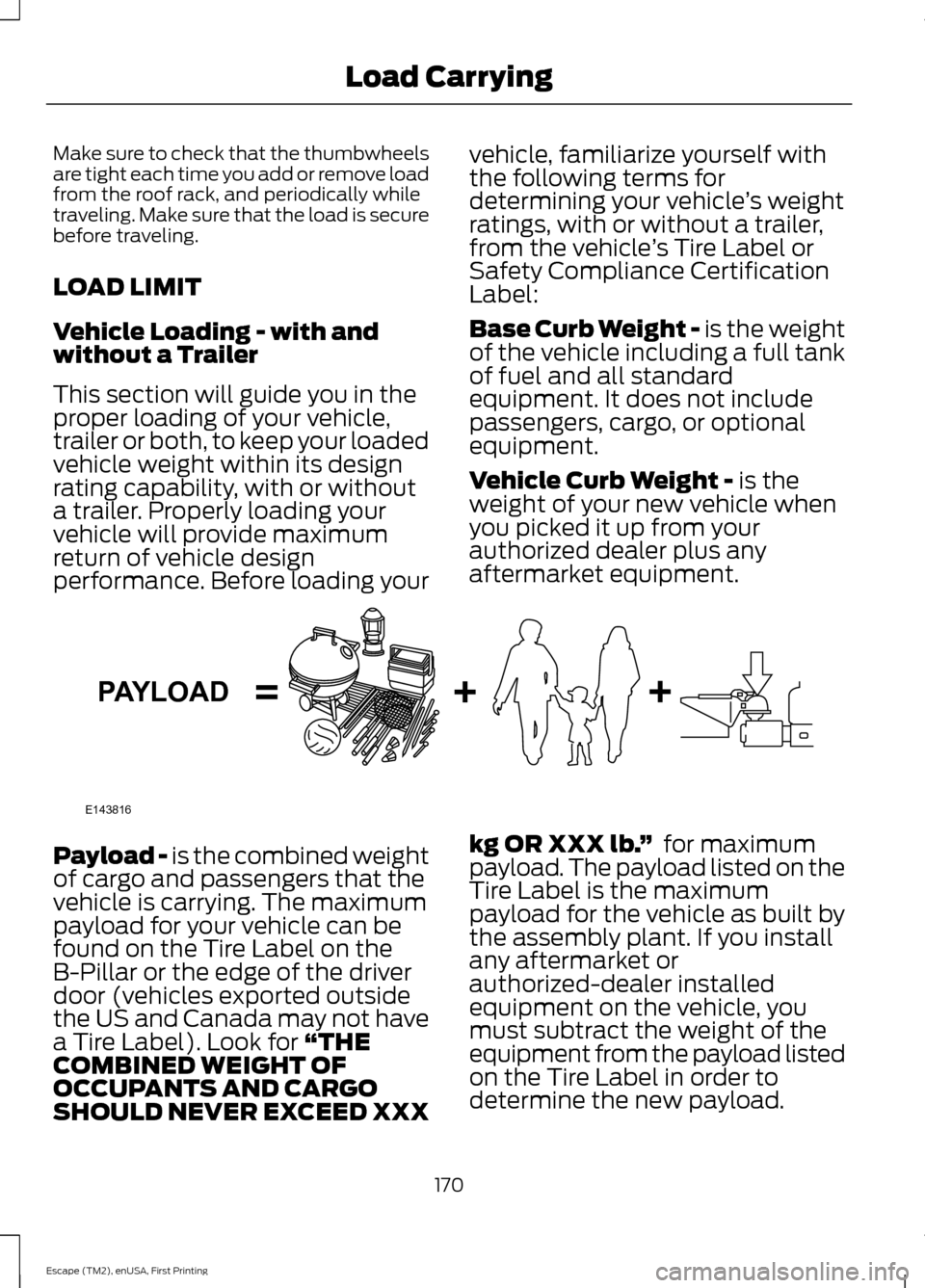
Make sure to check that the thumbwheels
are tight each time you add or remove load
from the roof rack, and periodically while
traveling. Make sure that the load is secure
before traveling.
LOAD LIMIT
Vehicle Loading - with and
without a Trailer
This section will guide you in the
proper loading of your vehicle,
trailer or both, to keep your loaded
vehicle weight within its design
rating capability, with or without
a trailer. Properly loading your
vehicle will provide maximum
return of vehicle design
performance. Before loading your
vehicle, familiarize yourself with
the following terms for
determining your vehicle
’s weight
ratings, with or without a trailer,
from the vehicle ’s Tire Label or
Safety Compliance Certification
Label:
Base Curb Weight - is the weight
of the vehicle including a full tank
of fuel and all standard
equipment. It does not include
passengers, cargo, or optional
equipment.
Vehicle Curb Weight -
is the
weight of your new vehicle when
you picked it up from your
authorized dealer plus any
aftermarket equipment. Payload -
is the combined weight
of cargo and passengers that the
vehicle is carrying. The maximum
payload for your vehicle can be
found on the Tire Label on the
B-Pillar or the edge of the driver
door (vehicles exported outside
the US and Canada may not have
a Tire Label). Look for
“THE
COMBINED WEIGHT OF
OCCUPANTS AND CARGO
SHOULD NEVER EXCEED XXX kg OR XXX lb.
” for maximum
payload. The payload listed on the
Tire Label is the maximum
payload for the vehicle as built by
the assembly plant. If you install
any aftermarket or
authorized-dealer installed
equipment on the vehicle, you
must subtract the weight of the
equipment from the payload listed
on the Tire Label in order to
determine the new payload.
170
Escape (TM2), enUSA, First Printing Load CarryingE143816PAYLOAD
Page 235 of 449
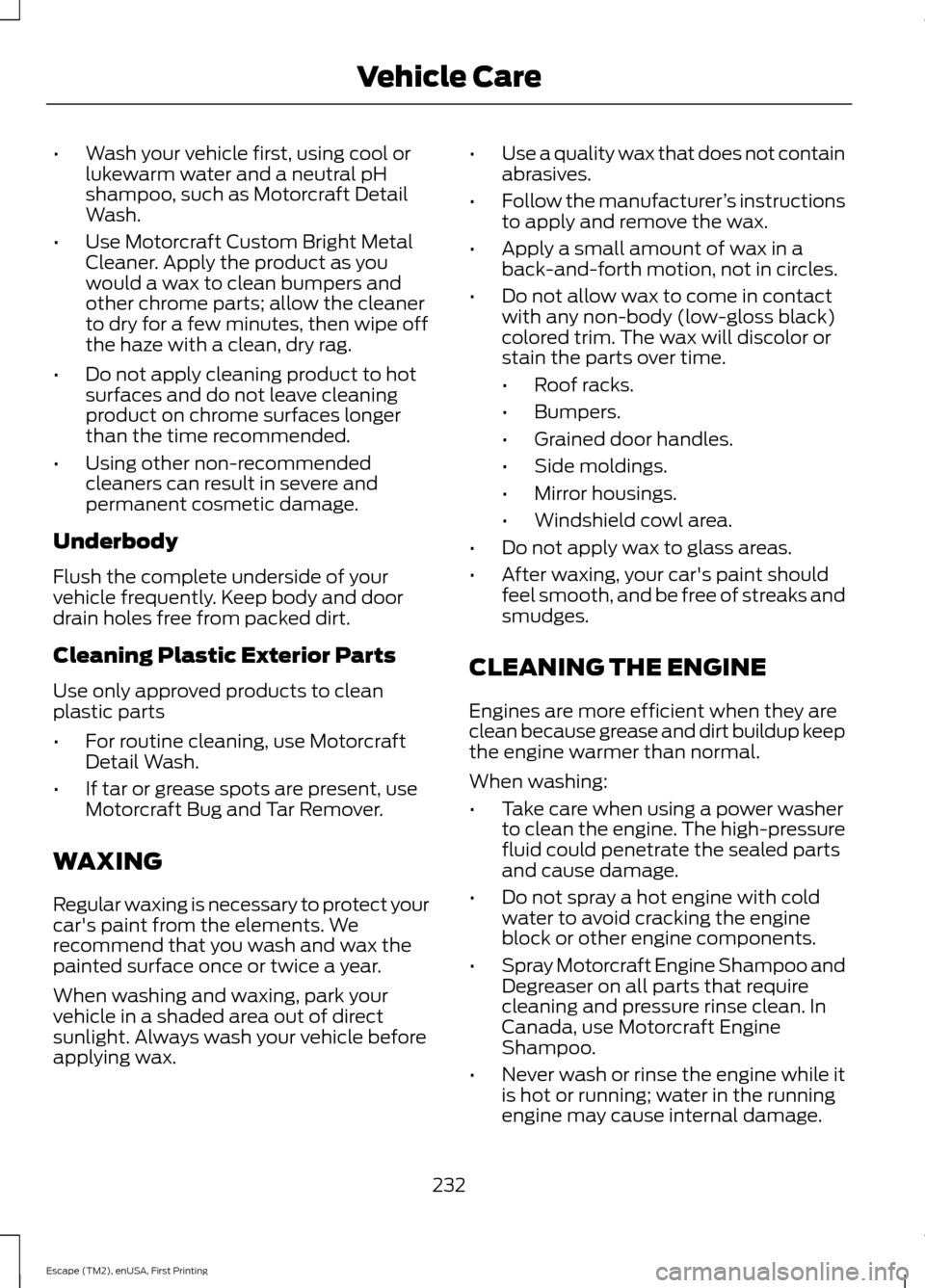
•
Wash your vehicle first, using cool or
lukewarm water and a neutral pH
shampoo, such as Motorcraft Detail
Wash.
• Use Motorcraft Custom Bright Metal
Cleaner. Apply the product as you
would a wax to clean bumpers and
other chrome parts; allow the cleaner
to dry for a few minutes, then wipe off
the haze with a clean, dry rag.
• Do not apply cleaning product to hot
surfaces and do not leave cleaning
product on chrome surfaces longer
than the time recommended.
• Using other non-recommended
cleaners can result in severe and
permanent cosmetic damage.
Underbody
Flush the complete underside of your
vehicle frequently. Keep body and door
drain holes free from packed dirt.
Cleaning Plastic Exterior Parts
Use only approved products to clean
plastic parts
• For routine cleaning, use Motorcraft
Detail Wash.
• If tar or grease spots are present, use
Motorcraft Bug and Tar Remover.
WAXING
Regular waxing is necessary to protect your
car's paint from the elements. We
recommend that you wash and wax the
painted surface once or twice a year.
When washing and waxing, park your
vehicle in a shaded area out of direct
sunlight. Always wash your vehicle before
applying wax. •
Use a quality wax that does not contain
abrasives.
• Follow the manufacturer ’s instructions
to apply and remove the wax.
• Apply a small amount of wax in a
back-and-forth motion, not in circles.
• Do not allow wax to come in contact
with any non-body (low-gloss black)
colored trim. The wax will discolor or
stain the parts over time.
•Roof racks.
• Bumpers.
• Grained door handles.
• Side moldings.
• Mirror housings.
• Windshield cowl area.
• Do not apply wax to glass areas.
• After waxing, your car's paint should
feel smooth, and be free of streaks and
smudges.
CLEANING THE ENGINE
Engines are more efficient when they are
clean because grease and dirt buildup keep
the engine warmer than normal.
When washing:
• Take care when using a power washer
to clean the engine. The high-pressure
fluid could penetrate the sealed parts
and cause damage.
• Do not spray a hot engine with cold
water to avoid cracking the engine
block or other engine components.
• Spray Motorcraft Engine Shampoo and
Degreaser on all parts that require
cleaning and pressure rinse clean. In
Canada, use Motorcraft Engine
Shampoo.
• Never wash or rinse the engine while it
is hot or running; water in the running
engine may cause internal damage.
232
Escape (TM2), enUSA, First Printing Vehicle Care
Page 399 of 449
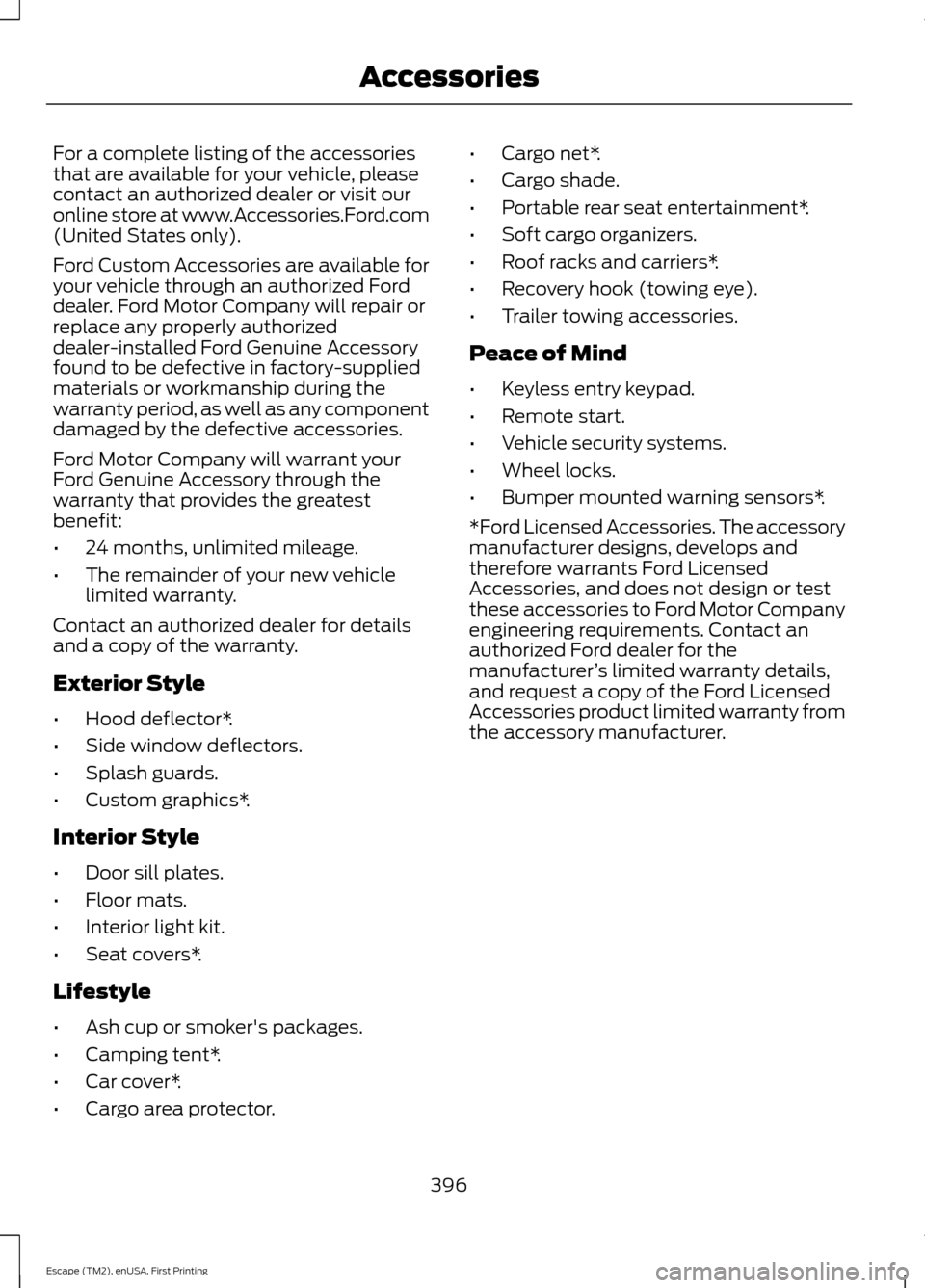
For a complete listing of the accessories
that are available for your vehicle, please
contact an authorized dealer or visit our
online store at www.Accessories.Ford.com
(United States only).
Ford Custom Accessories are available for
your vehicle through an authorized Ford
dealer. Ford Motor Company will repair or
replace any properly authorized
dealer-installed Ford Genuine Accessory
found to be defective in factory-supplied
materials or workmanship during the
warranty period, as well as any component
damaged by the defective accessories.
Ford Motor Company will warrant your
Ford Genuine Accessory through the
warranty that provides the greatest
benefit:
•
24 months, unlimited mileage.
• The remainder of your new vehicle
limited warranty.
Contact an authorized dealer for details
and a copy of the warranty.
Exterior Style
• Hood deflector*.
• Side window deflectors.
• Splash guards.
• Custom graphics*.
Interior Style
• Door sill plates.
• Floor mats.
• Interior light kit.
• Seat covers*.
Lifestyle
• Ash cup or smoker's packages.
• Camping tent*.
• Car cover*.
• Cargo area protector. •
Cargo net*.
• Cargo shade.
• Portable rear seat entertainment*.
• Soft cargo organizers.
• Roof racks and carriers*.
• Recovery hook (towing eye).
• Trailer towing accessories.
Peace of Mind
• Keyless entry keypad.
• Remote start.
• Vehicle security systems.
• Wheel locks.
• Bumper mounted warning sensors*.
*Ford Licensed Accessories. The accessory
manufacturer designs, develops and
therefore warrants Ford Licensed
Accessories, and does not design or test
these accessories to Ford Motor Company
engineering requirements. Contact an
authorized Ford dealer for the
manufacturer ’s limited warranty details,
and request a copy of the Ford Licensed
Accessories product limited warranty from
the accessory manufacturer.
396
Escape (TM2), enUSA, First Printing Accessories
Page 444 of 449
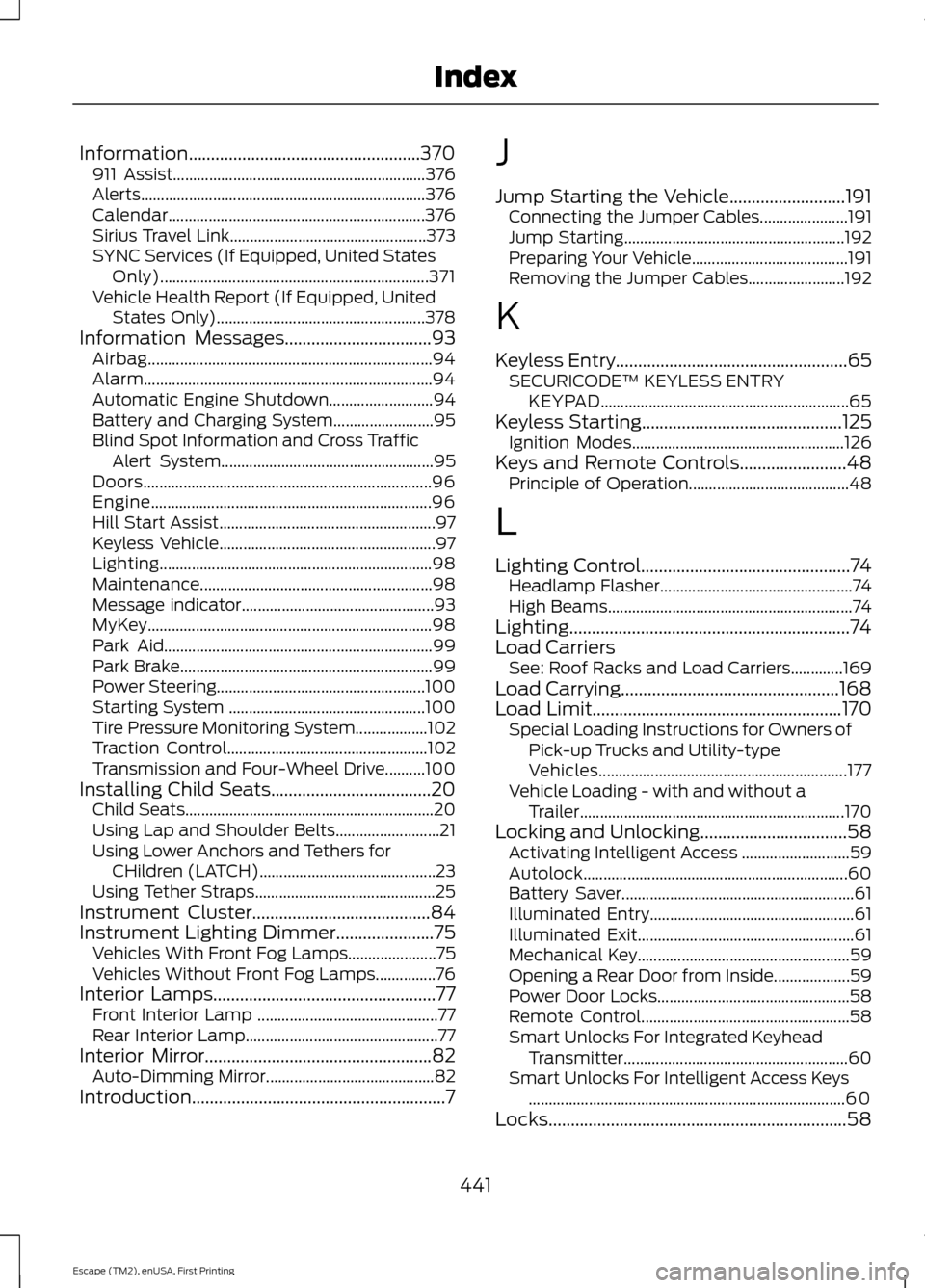
Information....................................................370
911 Assist............................................................... 376
Alerts....................................................................... 376
Calendar................................................................ 376
Sirius Travel Link................................................. 373
SYNC Services (If Equipped, United States Only)................................................................... 371
Vehicle Health Report (If Equipped, United States Only).................................................... 378
Information Messages.................................93
Airbag....................................................................... 94
Alarm........................................................................\
94
Automatic Engine Shutdown.......................... 94
Battery and Charging System......................... 95
Blind Spot Information and Cross Traffic Alert System..................................................... 95
Doors........................................................................\
96
Engine...................................................................... 96
Hill Start Assist...................................................... 97
Keyless Vehicle...................................................... 97
Lighting.................................................................... 98
Maintenance.......................................................... 98
Message indicator................................................ 93
MyKey....................................................................... 98
Park Aid................................................................... 99
Park Brake............................................................... 99
Power Steering.................................................... 100
Starting System ................................................. 100
Tire Pressure Monitoring System.................. 102
Traction Control.................................................. 102
Transmission and Four-Wheel Drive..........100
Installing Child Seats....................................20 Child Seats.............................................................. 20
Using Lap and Shoulder Belts.......................... 21
Using Lower Anchors and Tethers for CHildren (LATCH)............................................ 23
Using Tether Straps............................................. 25
Instrument Cluster
........................................84
Instrument Lighting Dimmer......................75
Vehicles With Front Fog Lamps...................... 75
Vehicles Without Front Fog Lamps...............76
Interior Lamps
..................................................77
Front Interior Lamp ............................................. 77
Rear Interior Lamp................................................ 77
Interior Mirror
...................................................82
Auto-Dimming Mirror.......................................... 82
Introduction.........................................................7 J
Jump Starting the Vehicle..........................191
Connecting the Jumper Cables...................... 191
Jump Starting....................................................... 192
Preparing Your Vehicle....................................... 191
Removing the Jumper Cables........................ 192
K
Keyless Entry
....................................................65
SECURICODE™ KEYLESS ENTRY
KEYPAD.............................................................. 65
Keyless Starting.............................................125 Ignition Modes..................................................... 126
Keys and Remote Controls
........................48
Principle of Operation........................................ 48
L
Lighting Control
...............................................74
Headlamp Flasher................................................ 74
High Beams............................................................. 74
Lighting...............................................................74
Load Carriers See: Roof Racks and Load Carriers.............169
Load Carrying.................................................168
Load Limit
........................................................170
Special Loading Instructions for Owners of
Pick-up Trucks and Utility-type
Vehicles.............................................................. 177
Vehicle Loading - with and without a Trailer.................................................................. 170
Locking and Unlocking
.................................58
Activating Intelligent Access ........................... 59
Autolock.................................................................. 60
Battery Saver.......................................................... 61
Illuminated Entry................................................... 61
Illuminated Exit...................................................... 61
Mechanical Key..................................................... 59
Opening a Rear Door from Inside................... 59
Power Door Locks................................................ 58
Remote Control.................................................... 58
Smart Unlocks For Integrated Keyhead Transmitter........................................................ 60
Smart Unlocks For Intelligent Access Keys ........................................................................\
....... 60
Locks...................................................................58
441
Escape (TM2), enUSA, First Printing Index
Page 446 of 449
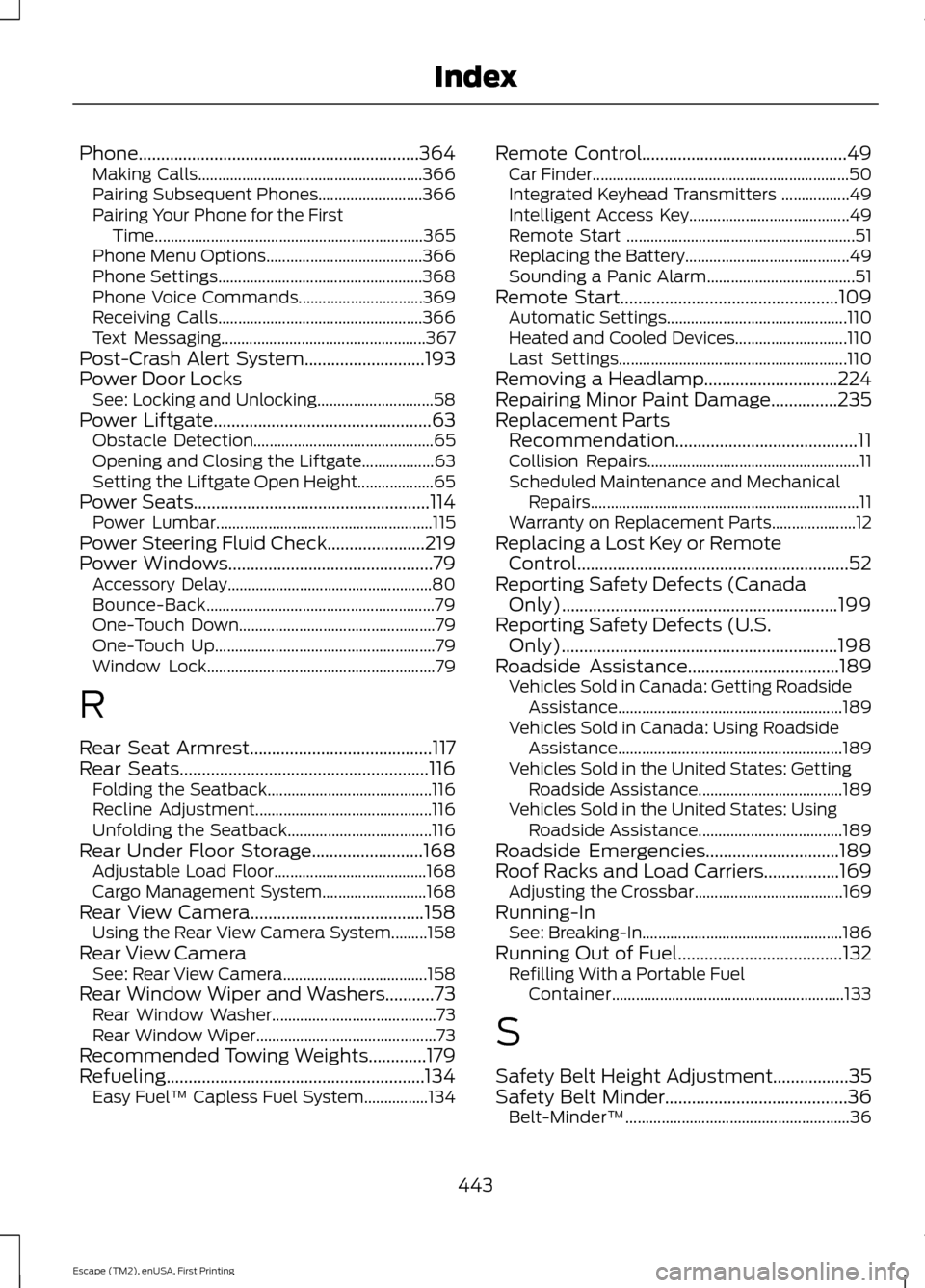
Phone...............................................................364
Making Calls........................................................ 366
Pairing Subsequent Phones.......................... 366
Pairing Your Phone for the First Time................................................................... 365
Phone Menu Options....................................... 366
Phone Settings................................................... 368
Phone Voice Commands............................... 369
Receiving Calls................................................... 366
Text Messaging................................................... 367
Post-Crash Alert System...........................193
Power Door Locks See: Locking and Unlocking............................. 58
Power Liftgate
.................................................63
Obstacle Detection............................................. 65
Opening and Closing the Liftgate.................. 63
Setting the Liftgate Open Height................... 65
Power Seats
.....................................................114
Power Lumbar...................................................... 115
Power Steering Fluid Check......................219
Power Windows
..............................................79
Accessory Delay................................................... 80
Bounce-Back......................................................... 79
One-Touch Down................................................. 79
One-Touch Up....................................................... 79
Window Lock......................................................... 79
R
Rear Seat Armrest
.........................................117
Rear Seats........................................................116 Folding the Seatback......................................... 116
Recline Adjustment............................................ 116
Unfolding the Seatback.................................... 116
Rear Under Floor Storage.........................168 Adjustable Load Floor...................................... 168
Cargo Management System.......................... 168
Rear View Camera
.......................................158
Using the Rear View Camera System.........158
Rear View Camera See: Rear View Camera.................................... 158
Rear Window Wiper and Washers
...........73
Rear Window Washer......................................... 73
Rear Window Wiper............................................. 73
Recommended Towing Weights.............179
Refueling..........................................................134 Easy Fuel ™ Capless Fuel System................134 Remote Control
..............................................49
Car Finder................................................................ 50
Integrated Keyhead Transmitters .................49
Intelligent Access Key........................................ 49
Remote Start ......................................................... 51
Replacing the Battery......................................... 49
Sounding a Panic Alarm..................................... 51
Remote Start.................................................109 Automatic Settings............................................. 110
Heated and Cooled Devices............................ 110
Last Settings......................................................... 110
Removing a Headlamp
..............................224
Repairing Minor Paint Damage...............235
Replacement Parts Recommendation.........................................11
Collision Repairs..................................................... 11
Scheduled Maintenance and Mechanical Repairs................................................................... 11
Warranty on Replacement Parts..................... 12
Replacing a Lost Key or Remote Control.............................................................52
Reporting Safety Defects (Canada Only)
..............................................................199
Reporting Safety Defects (U.S. Only)..............................................................198
Roadside Assistance
..................................189
Vehicles Sold in Canada: Getting Roadside
Assistance........................................................ 189
Vehicles Sold in Canada: Using Roadside Assistance........................................................ 189
Vehicles Sold in the United States: Getting Roadside Assistance.................................... 189
Vehicles Sold in the United States: Using Roadside Assistance.................................... 189
Roadside Emergencies
..............................189
Roof Racks and Load Carriers.................169 Adjusting the Crossbar..................................... 169
Running-In See: Breaking-In.................................................. 186
Running Out of Fuel.....................................132 Refilling With a Portable Fuel
Container.......................................................... 133
S
Safety Belt Height Adjustment.................35
Safety Belt Minder.........................................36 Belt-Minder™........................................................ 36
443
Escape (TM2), enUSA, First Printing Index